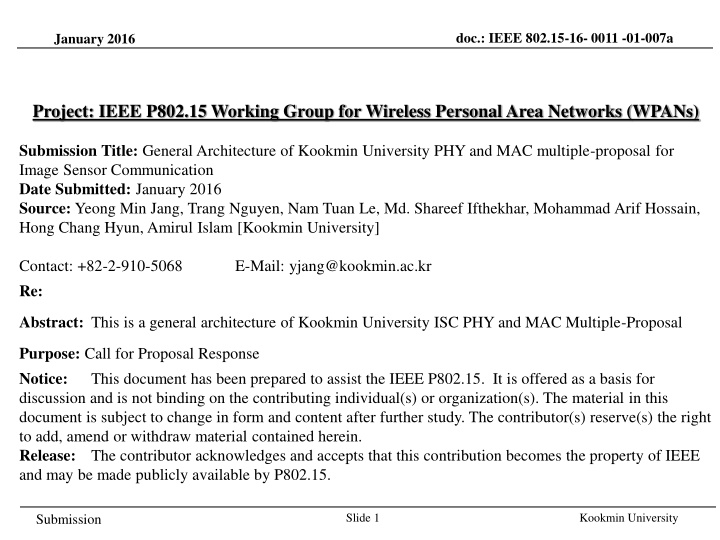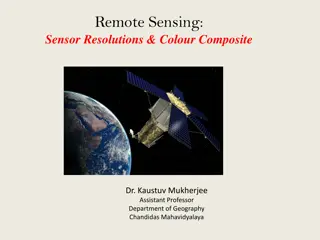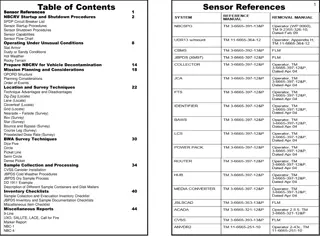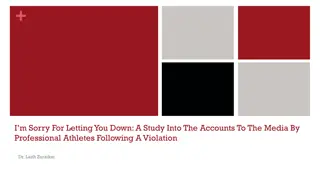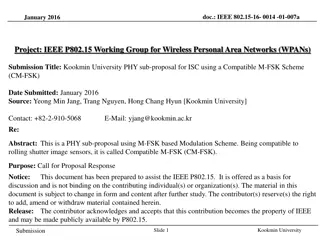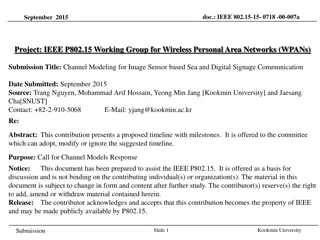General Architecture of Kookmin University's Image Sensor Communication Proposal
Kookmin University submitted a proposal to the IEEE P802.15 Working Group for Wireless Personal Area Networks, focusing on the PHY and MAC layers for image sensor communication. The document outlines design principles, specifications, frame formats, and considerations for both layers. Definitions related to optical clock rate, symbol rate, modulation rate, clock information, frame rate variation, shutter speed, and sampling rate are discussed in detail.
Download Presentation

Please find below an Image/Link to download the presentation.
The content on the website is provided AS IS for your information and personal use only. It may not be sold, licensed, or shared on other websites without obtaining consent from the author.If you encounter any issues during the download, it is possible that the publisher has removed the file from their server.
You are allowed to download the files provided on this website for personal or commercial use, subject to the condition that they are used lawfully. All files are the property of their respective owners.
The content on the website is provided AS IS for your information and personal use only. It may not be sold, licensed, or shared on other websites without obtaining consent from the author.
E N D
Presentation Transcript
doc.: IEEE 802.15-16- 0011 -01-007a January 2016 Project: IEEE P802.15 Working Group for Wireless Personal Area Networks (WPANs) Submission Title: General Architecture of Kookmin University PHY and MAC multiple-proposal for Image Sensor Communication Date Submitted: January 2016 Source: Yeong Min Jang, Trang Nguyen, Nam Tuan Le, Md. Shareef Ifthekhar, Mohammad Arif Hossain, Hong Chang Hyun, Amirul Islam [Kookmin University] Contact: +82-2-910-5068 Re: E-Mail: yjang@kookmin.ac.kr Abstract: This is a general architecture of Kookmin University ISC PHY and MAC Multiple-Proposal Purpose: Call for Proposal Response Notice: This document has been prepared to assist the IEEE P802.15. It is offered as a basis for discussion and is not binding on the contributing individual(s) or organization(s). The material in this document is subject to change in form and content after further study. The contributor(s) reserve(s) the right to add, amend or withdraw material contained herein. Release: The contributor acknowledges and accepts that this contribution becomes the property of IEEE and may be made publicly available by P802.15. Slide 1 Kookmin University Submission
doc.: IEEE 802.15-16- 0011 -01-007a January 2016 Content PHY Layer Introduction Definitions PHY design principles and considerations Compatibility features PHY layer specification PHY modes PHY frame format class I PHY frame format class II Error correction MAC Layer specification MAC considerations General MAC frame format Broadcast/Beacon MAC frame format Data transfer MAC frame format Command MAC frame format Slide 2 Kookmin University Submission
January 2016 doc.: IEEE 802.15-16- 0011 -01-007a PHY Layer Introduction Slide 3 Kookmin University Submission
January 2016 doc.: IEEE 802.15-16- 0011 -01-007a Definitions optical clock rate: The frequency at which the data is clocked out to the optical source. symbol rate: The number of different symbols across the transmission medium per time. It shows how fast the data symbol is clocked out (e.g. 10 symbol/sec). Note that a symbol definition is up to the modulation scheme. modulation rate: This term is used only for LED use case to show how fast LED is modulated. clock information (of a data packet/symbol): The information represents the state of a symbol clocked out. The clock information is transmitted along with a symbol to help a receiver identifying an arrival state of new symbol under presence of frame rate variation. frame rate variation: This term is applied for a typical camera when a fixed frame rate video mode is not supported or an auto-frame rate mode is selected by a software application. The frame rate variation is limited by the range of frame rate (frame rate range) frame rate range: The range observed of frame rate in a selected video mode which is lower limited by the minimum practical frame rate and upper limited by the maximum practical frame rate during the recording time. varying shutter speed: Shutter speed stands for the length of time a camera shutter is open to expose light into the image sensor. Auto- exposure in video mode causes the variation in shutter speed, hence the available bandwidth is varying. sampling rate: The number of rows are sequentially obtained per time in a rolling shutter image sensor (also known as row-scanning rate). However, in a global shutter image sensor, the frame rate is equal to the sampling rate. rolling sampling rate: the practical sampling rate observed from the selected resolution mode of an output image. By using a output image to extract data, the practical sampling rate is less than the sampling rate in an image sensor because the output image resolution is reduced. spatial scheme: The communications scheme to solve the problem of frame-rate variation in the receiver by transmitting data along with its clock information spatially. A spatial-MIMO transmitter is used in this scheme. Spatial M-PSK (SM-PSK): A communications scheme in which a group of LEDs consists of multiple LEDs which are modulated at different phases together transmit a phase spatially. At a time, the camera captures multiple states of those LEDs (a group of LEDs) and uses those states to decode a transmitted phase, outputting a data symbol. dimmable spatial M-PSK (DSM-PSK): A specific form of SM-PSK in which dimming is supported in steps of 1/M. reference LEDs: In the spatial scheme, the reference-LEDs do not transmit any data but a reference signal (a specific form of clock information) to help a varying frame-rate receiver decoding data. data LEDs: The LEDs which transmit data in the spatial scheme. Slide 4 Kookmin University Submission
January 2016 doc.: IEEE 802.15-16- 0011 -01-007a temporal scheme: The communications scheme to solve the problem of frame-rate variation in the receiver by transmitting data along with its clock information together as one packet. asynchronous bit/symbol: a form of clock information in the temporal scheme to solve frame rate variation problem. interrupted Lighthouse-to-Ship: Lighthouse rotation causes to the cyclical interruption in transmission from lighthouse to ship. The period of repetition is about 9s for example. frequency-domain scheme: The communications scheme to solve the problem of frame-rate variation in the receiver. A data along with its clock information together are transmitted as one symbol. But before transmission, the packet is encoded in frequency domain. Compatible Multiple-Frequency Shift Keying (CM-FSK): The modified M-FSK scheme to be compatible to a varying frame-rate camera receiver by transforming a data packet along with its clock information together into a frequency symbol. Additionally, CM-FSK also supports compatibility in different sampling rates at different rolling shutter receivers. Compatible On-Off-Keying (C-OOK): The modified OOK scheme to be compatible to a varying frame-rate camera receiver by transmitting data along with its clock information together as one packet. Additionally, C-OOK also supports compatibility in different sampling rates at different rolling shutter receivers. Compatible Color-Shift-Keying (C-CSK): a modification of CSK scheme to be compatible to a varying frame-rate camera receiver. rolling effect: This happens in a rolling shutter camera receiver in which camera exposes sequentially to light. Different LEDs may be captured at different time instances on an image due to the rolling effect. majority symbol voting: When the frame rate of a camera receiver is much less than the symbol rate of a transmitter, a symbol which is transmitted multiple times will be re-captured multiple times. The clock information of a symbol shows that the symbol is repeated or first time transmitted. The majority voting scheme which is applied to vote all captured symbols on a same clock to output a data symbol can enhance error rate. available bandwidth: the bandwidth limited by the upper physical limit of camera; typically by the shutter speed. The lower limit for the available bandwidth is defined by eye cut-off frequency, e.g. 200Hz, for flicker-free application. global exposure time (or capturing time): This term is used specifically in rolling shutter camera to differentiate with the exposure time (the time a row of pixel in an image sensor exposes to light). It is the time from the moment the first-row shutter opens to the moment the last-row shutter close. Rolling -shutter Packet period to Frame interval Ratio (RPFR): This term is applied in C-OOK scheme in which a processed rolling image outputs a data packet. The ratio of the period of the data packet decoded from an rolling image to the frame interval shows how efficiency the transmission is. Slide 5 Kookmin University Submission
doc.: IEEE 802.15-16- 0011 -01-007a January 2016 PHY Design principles and Considerations: Compatibility Support for Commercial Cameras Compatible to varying frame-rates Compatible to sampling rates/shutter speeds Compatible to both global shutter and rolling shutter receivers. Compatible to different resolutions Performance (e.g. link rate, distance) is considered when the available bandwidth is narrow. Low overhead transmission mode will be supported. Dimming Support (the step of dimming depends on a specific application) Localization Identification of multiple transmitters Slide 6 Kookmin University Submission
doc.: IEEE 802.15-16- 0011 -01-007a January 2016 Compatibility to varying-frame-rates Assume that: A camera has a varying frame-rate within a variation range that is different from the other cameras . The variation in frame rate is irregular, but for communications let assume it is always above a specific value (e.g. 10fps). (If anytime the frame rate drops to below the condition, e.g. 10fps, the FEC is required to correct error lately) Three solutions are proposed: Temporal Scheme (Compatible-OOK) Data along with its clock information are transmitted as one packet. Spatial Scheme (Spatial M-PSK/ Dimmable Spatial M-PSK) Clock information is also encoded spatially with data. We call those LEDs which transmit reference signal (clock information of a data symbol) are reference-LEDs. The other LEDs which transmit data are called data-LEDs. Frequency Domain Scheme (Compatible M-FSK) Data along with its clock information are transmitted as one symbol. But before transmission, the packet is encoded in frequency domain. Slide 7 Kookmin University Submission
doc.: IEEE 802.15-16- 0011 -01-007a January 2016 Compatibility to varying-frame-rates Slide 8 Kookmin University Submission
doc.: IEEE 802.15-16- 0011 -01-007a January 2016 Compatibility to different sampling-rates/shutter speeds Different sampling rates problem In Image Sensor Communications system using M-FSK modulation scheme and a rolling shutter camera receiver, a rolling shutter camera has a different sampling rate and a different shutter speed from the other rolling shutter cameras . Solution: Compatibility Support for different sampling-rates/shutter speeds by using Data Frame Structure with a specific frame (a training frame) Compatibility-support frame (training frame) Data frame Data frame The roles of a compatibility-support frame Training: Helps a receiver previewing and self-identifying the sampling rate (kHz). The value of sampling rate (a constant in an image sensor) will be restored and used for decoding of the following data packets. Slide 9 Kookmin University Submission
doc.: IEEE 802.15-16- 0011 -01-007a January 2016 Compatibility to global shutter and rolling shutter Performance (Link rate) (for only rolling shutter in case of M >2) (for only global shutter in case of M >2) Highest DSM-PSK Hybrid M-PSK.M-FSK For rolling shutter (Dimmable Spatial M-PSK) No (M >2) CM-FSK (Compatible M-FSK) Compatible to both types of shutter YES (M =2) Lowest 2-FSK 2 Spatial 2-PSK 1 1 Our spatial 2-PSK (a subset of SM-PSK) is proposed to be compatible to both global and rolling shutter types, and compatible to varying frame-rate cameras. Both Shutters Support 2 Our CM-FSK scheme which is designed mainly for rolling shutter types can support for a varying frame-rate and be compatible to different sampling rates/shutter speeds. If the number of frequency, M>2, global shutter is not supported. 2-FSK can support for both types of shutter. Our hybrid M-PSK/CM-FSK is proposed to give best performance in rolling shutter type with supports for a varying frame-rate and different sampling rates/shutter speeds. Dimming is also supported by performing PWM in FSK. Slide 10 Kookmin University Submission
doc.: IEEE 802.15-16- 0011 -01-007a January 2016 Compatibility to global shutters and rolling shutters Color Transmission (C-CSK) This scheme is compatible to both global shutter and rolling shutter types because the symbol rate of transmission is less than the minimum frame rate of a camera. The rolling effect is also considered and mitigated in our C-CSK scheme on a rolling shutter receiver. (Rolling effect causes the problem that different LEDs may be captured at different time instances) OOK Scheme (C-OOK) This scheme is not designed to be compatible to global shutter type. Only rolling shutter type is considered as a receiver. (optical clock rate is about several kHz to target high performance of rolling shutter receiver which has sampling rate up to tens of kHz) (The C-OOK mainly supports compatibility in frame rate variation and different sampling rates.) Slide 11 Kookmin University Submission
doc.: IEEE 802.15-16- 0011 -01-007a January 2016 Compatibility to resolutions Problem The high resolution causes to the long readout time and post-processing time, reducing the frame rate of a camera receiver. A camera has a different capacity of resolution and frame rate limit from the other s. The resolution should be small enough to target high frame rate range, e.g. above 20fps (to avoid missing data when dropping frame rate to below the symbol rate of transmission). The sampling rate on an rolling image sensor is constant. However, by reducing resolution in read-out process, the downsampled image causes reducing the rolling sampling rate practically. Solution: A camera receiver operates a preview mode before getting data in order to select the proper resolution mode in which the frame rate range is suitable for communications (i.e. above the symbol rate, 20fps for example). Higher frame rate range is better for error correction in using majority symbol voting. Especially in the rolling shutter receiver, the selected resolution should provide a rolling sampling rate high enough for the reliable communications. Slide 12 Kookmin University Submission
doc.: IEEE 802.15-16- 0011 -01-007a January 2016 PHY modes The IEEE 802.15.7 specification classified PHY types into PHY I, PHY II and PHY III upon the data rate. Our proposed PHY modes for Image Sensor Communications belong to PHY I. Slide 13 Kookmin University Submission
doc.: IEEE 802.15-16- 0011 -01-007a January 2016 PHY modes (TBD) Low-rate PHY I modes (Flicker-free) Modulation Line Coding Symbol rate Data rate Compatibility features support: varying frame-rates (YES); shutter speeds/sampling rates (YES); rolling shutter type (YES); global shutter type (YES if 2-FSK). : CM-FSK or hybrid CM-FSK/ M-PSK : None : 5/10/15 (symbol/sec) : 20 bps 120 bps Medium-rate PHY I modes (Flicker-free) Modulation Line Coding Optical clock rate Data rate Compatibility features support: varying frame-rates (YES); shutter speeds/sampling rates (YES); rolling shutter type (YES); global shutter type (NO). : C-OOK : Manchester/4B6B/8B10B : 2 kHz/ 4 kHz : 500 bps 3.2 kbps Symbol rate : 5/10/15 (symbol/sec) High-rate PHY I modes (Spatial MIMO) Slide 14 Kookmin University Submission
doc.: IEEE 802.15-16- 0011 -01-007a January 2016 PHY modes (TBD) continue High-rate PHY I modes (Spatial MIMO) Color Transmission (Flicker) Spatial-MIMO LEDs (Flicker-free) Modulation Symbol rate Data rate Compatibility features: varying frame-rates (YES); rolling shutter type (YES); global shutter type (YES). : C-CSK : 5/10/15 (symbol/sec) : kbps Mbps Modulation Symbol rate : 5/ 10/ 15 (symbol/sec) Data rate : kbps Mbps Compatibility features: varying frame-rates (YES); global shutter type (YES); rolling shutter type (NO). : SM-PSK/ DSM-PSK Slide 15 Kookmin University Submission
doc.: IEEE 802.15-16- 0011 -01-007a January 2016 Low-rate PHY I modes (Flicker-free) Data rate Compatibility Support Varying frame rates Sampling rates Y Y Y Y Y Symbol Rate (symbol/sec) 5/ 10/ 15 5/ 10/ 15 5/ 10/ 15 5/ 10/ 15 5/ 10/ 15 Shutter speeds/ Shutter type Both Rolling Rolling Rolling Rolling Modulation S2-PSK * 32-FSK hybrid 32-FSK/ 2-PSK hybrid 64-FSK/ 2-PSK hybrid 64-FSK/ 4-PSK (e.g. 10 sym/sec) 10 bps 50 bps 60 bps 70 bps 80 bps 1 2 3 4 5 Y Y Y Y Y Low rate PHY I *S2-PSK scheme (Spatial 2-PSK) uses a couple of LEDs to transmit data. The inverse relation in phases of two LEDs blinks bit 0; otherwise the similarity in phases blinks bit 1. Other supports: In a hybrid M-FSK and M-PSK scheme, dimming is supported in FSK by performing PWM. The maximum number of frequencies is limited by the available bandwidth (B) divided by frequency separation ( f ): Number_of_frequency = (B/ f) Slide 16 Kookmin University Submission
doc.: IEEE 802.15-16- 0011 -01-007a January 2016 Medium-rate PHY I modes (Flicker-free) Data rate Compatibility Support Optical Clock rate 2 kHz 2 kHz 2 kHz 4 kHz 4 kHz Varying frame rates Y Y Y Y Y Symbol rate 5/ 10/ 15 5/ 10/ 15 5/ 10/ 15 5/ 10/ 15 5/ 10/ 15 (e.g. Shutter speeds/ Sampling rates shutter type Y Y Y Y Y Modulation C-OOK C-OOK C-OOK C-OOK C-OOK Coding Manchester Manchester 4B6B 4B6B 8B10B RPFR 25% 50% 50% 50% 50% 10 sym/s) 84 bps 0.17 kbps 0.22 kbps 0.44 kbps 0.53 kbps 6 7 8 9 Rolling Rolling Rolling Rolling Rolling Medium PHY I (kbps) 10 Data rate = (optical clock rate) x (RPFR) x (symbol rate) Other supports: Dimming is supported in OOK by performing dimmed-OOK. In rolling shutter receiver, the maximum optical clock rate is limited by the observed sampling rate (about tens of kS/s) and the shutter speed (about 8 kHz for typical smartphone cameras). A rolling shutter camera has an global exposure time which is different from the other rolling shutter camera s. The value of global exposure time is a limitation to the data packet length. Slide 17 Kookmin University Submission
doc.: IEEE 802.15-16- 0011 -01-007a January 2016 High-rate PHY I modes (Flicker and Flicker-free) Data rate Compatibility Support Varying frame rates speeds (e.g. 10 symbol/s) Shutter shutter type High PHY I modes Modulation Symbol Rate (/sec) n/a Both 11 12 13 14 15 C-2CSK (OOK) C-4CSK (4 Color) C-8CSK (8 Color) C-2CSK (OOK) C-4CSK (4 Color) 5/ 10/ 15 5/ 10/ 15 5/ 10/ 15 5/ 10/ 15 5/ 10/ 15 2.5 kbps 5 kbps 7.5 kbps 40 kbps 80 kbps Y Y Y Y Y Flicker (16 x 16) n/a n/a n/a n/a Y Both Both Both Both Global Flicker (64 x 64) S2-PSK 5/ 10/ 15 2.5 kbps 16 Y Flicker-free (16 x 16) Global Global Global Y Y Y S8-PSK Dimmable S8-PSK 5/ 10/ 15 5/ 10/ 15 1.92 kbps 0.96 kbps 17 18 Y Y S2-PSK 5/ 10/ 15 40 kbps 30.7 kbps 19 Y Flicker-free (64 x 64) Global S8-PSK 5/ 10/ 15 20 Y Y 15.3 kbps Global 21 Dimmable S8-PSK 5/ 10/ 15 Y Y Other supports: dimming is not proposed in color transmission. In dimmable spatial-MIMO M-PSK scheme (DSM-PSK), dimming is supported in steps of 1/M. Slide 18 Kookmin University Submission
doc.: IEEE 802.15-16- 0011 -01-007a January 2016 PHY I Frame Format for temporal and/or frequency-domain scheme class I Preamble and training SHR PHY header HCS PSDU PHR PHY payload PHY I Frame Format for spatial MIMO scheme class II Preamble PHY header HCS PSDU SHR PHR PHY payload Slide 19 Kookmin University Submission
doc.: IEEE 802.15-16- 0011 -01-007a January 2016 PHY I Frame Format for temporal (C-OOK) and/or frequency-domain(CM-FSK) scheme class I Slide 20 Kookmin University Submission
doc.: IEEE 802.15-16- 0011 -01-007a January 2016 Best Compatible Band Camera Physical limit Camera Physical limit Extended band CM-FSK/ C-OOK (extended band) CM-FSK scheme (on the best-compatible-band) PSDU length SHR symbol 1 SHR symbol 2 PSDU HCS MCS ID Reserved fSF f SF SHR PHR SHR and PHR design: This part should have compatibility to most of rolling shutter cameras CM-FSK is chosen because of its error rate advantages compared to C-OOK: Hence CM-FSK is more reliable in detection and synchronization The frequency band for encoding SHR and PHR is the low band. This is to ensure the accuracy and compatibility to any rolling shutter camera. The PSDU can keep CM-FSK scheme or switch to C-OOK scheme, and is performed on extended band to achieve higher link rate in specific situations. Slide 21 Kookmin University Submission
doc.: IEEE 802.15-16- 0011 -01-007a January 2016 best compatible band f'SF extended band fSF Camera limit . . . . . . ~8 kHz 32 frequency Data frequency: Preamble frequency: fi = fSF + i. f f SF = fSF + 33. f (i=1; 2; ; 32) Preamble design: On the lowest-band among the CM-FSK PHY modes to ensure compatibility with low sampling-rate cameras. Relationship between fSF and f SF is for training fSF is chosen as lowest frequency on the available bandwidth, e.g. 200Hz, to be easily detected. f SF = fSF + 33x f to train different cameras which have different sampling rates. Slide 22 Kookmin University Submission
doc.: IEEE 802.15-16- 0011 -01-007a January 2016 PHY header design: All frequencies used for PHY header are on low- band of the available bandwidth (e.g. 200Hz 2kHz). This is to be compatible to low sampling rate cameras. SHR and PHR are allocated in a common band (low-band) The length for each frequency symbol is constant throughout the frame between preamble, header, and payload PSDU can be allocated on the extended band. MCS indication PHY modes Data rate Unit 1 0000 0000 I.1 10 2 0000 0001 I.2 50 bps 3 0000 0010 I.3 60 4 0000 0011 I.4 70 80 5 0000 0100 I.5 6 0000 0101 I.6 84 7 0000 0110 I.7 0.17 8 0000 0111 I.8 kbps 0.22 9 0000 1000 I.9 0.44 10 0000 1001 I.10 0.53 32-FSK ==> (5 bit/symbol) MCS ID: 2 symbols (8 bit ID) 1 freq. symbol ==> 1 (asynchronous bit) and 4 (ID bits) Slide 23 Kookmin University Submission
doc.: IEEE 802.15-16- 0011 -01-007a January 2016 PHY Frame Format type II for spatial-MIMO scheme Slide 24 Kookmin University Submission
doc.: IEEE 802.15-16- 0011 -01-007a January 2016 spatial-MIMO (resolution mode 2) Spatial-MIMO (resolution mode 1) PSDU length PSDU HCS MCS ID Reserved symbol 1 symbol 2 s ? PHR SHR SHR and PHR design: On a low resolution to ensure compatibility to different resolutions versus distance. Slide 25 Kookmin University Submission
doc.: IEEE 802.15-16- 0011 -01-007a January 2016 Preamble design: Symbol its inverse form (s and ?) are to help receiver in identifying LEDs. Preamble symbols are at low spatial-resolution among spatial-MIMO PHY modes. symbol s symbol ? PSDU length HCS PSDU MCS ID Reserved Preamble resolution mode 2 resolution mode 1 constant symbol rate Although the resolution can be increased at PSDU, the symbol rate does not change throughout the frames between preamble, header, and payload. Any symbol rate should be pre-noticed Slide 26 Kookmin University Submission
doc.: IEEE 802.15-16- 0011 -01-007a January 2016 PHY header design: SHR and PHR are at the same resolution (lowest among spatial-MIMO PHY modes). Although the resolution can be increased at PSDU, the symbol rate does not change throughout the frame between preamble, header, and payload. Any symbol rate should be pre-noticed MCS indication PHY modes Data rate Unit Note 11 0000 1011 I.18 DS8-PSK 0.96 Flicker-free(16 x 16) 12 0000 1100 I.17 S8-PSK 1.92 13 0000 1101 I. 16 S2-PSK 2.5 14 0000 1110 I.11 C-2CSK 2.5 5 kbps Flicker (16 x 16) 15 0000 1111 I.12 C-4CSK 16 0001 0000 I.13 7.5 C-8CSK 17 0001 0001 I.21 DS8-PSK 15.3 Flicker-free(64 x 64) 18 0001 0010 I.20 S8-PSK 30.7 19 0001 0011 I.19 S2-PSK 40 20 0001 0100 I.14 C-2CSK 40 Flicker (64 x 64) 21 0001 0101 I.15 C-4CSK 80 22 - 256 reserved Slide 27 Kookmin University Submission
doc.: IEEE 802.15-16- 0011 -01-007a January 2016 PHY error correction: Clock information repetition SHR PHR PHY symbol 1 PHY symbol 1 PHY symbol 1 PHY symbol 2 PHY symbol 2 FCS PHY structure Camera sampling Majority Voting symbol 1 voting symbol 2 voting Note: For a simple error correction, a repetition of transmission and majority voting scheme are together applied. The camera sampling rate is faster than the symbol rate at any condition. The clock information becomes indispensable for the voting, especially under presence of frame rate variation. Two types of voting: a symbol (a group of bits) majority voting/ every single bit majority voting Slide 28 Kookmin University Submission
doc.: IEEE 802.15-16- 0011 -01-007a January 2016 PHY Summary 20 PHY modes were proposed up on modulation schemes Two PHY frame format Types: An common PHY frame format for Temporal/Frequency-Domain scheme CM-FSK and hybrid CM-FSK/M-PSK(<100 bps) C-OOK (100bps - 1kbps) An identical PHY frame format for both Spatial-MIMO schemes Flicker mode: Color transmission C-CSK (2.5kbps - 80kbps) Flicker-free mode: CM-PSK/DCM-PSK (100bps 3kbps) The symbol rate does not change throughout the frames between preamble, header, and payload. Any symbol rate should be pre-noticed Compatibility support in SHR and PHR design is highly considered. The lowest data mode among available PHY modes is used for both SHR and PHR. Low-band CM-FSK is used as common PHY for Temporal/Frequency-Domain scheme Low-resolution is used for SHR and PHR frames in spatial scheme. The DPSU can use the same PHY mode or upgrade to another PHY mode (higher data rate) among available PHY modes. The notice of DPSU PHY mode is MCS ID frame. The error is corrected by repeating transmission along with a majority voting. The clock information transmission is helpful (and indispensable) for the voting under presence of frame rate variation. Slide 29 Kookmin University Submission
doc.: IEEE 802.15-16- 0011 -01-007a January 2016 MAC Layer Slide 30 Kookmin University Submission
doc.: IEEE 802.15-16- 0011 -01-007a January 2016 Four MAC Types Kookmin MAC supports 4 modes based on applications/usages: Beacon broadcast (Low overhead beacon broadcast) mode Information Broadcast (IB) mode Bidirectional communication mode Device-to-Device (D2D) mode 1) Low-overhead beacon mode/ 3) Bidirectional Communications 4) D2D Mode 2) IB Mode Connected Coordinators Device 1 Sources Tag Tag Device 2 Tag Tag Tag Tag Unidirectional broadcast of beacon/information Bidirectional star topology Bidirectional unicast Slide 31 Kookmin University Submission
doc.: IEEE 802.15-16- 0011 -01-007a January 2016 MAC design principles Low complexity and low overhead. This is critical because of low data rate in ISC Flexibility a common MAC frame format for Beacon broadcast mode: The most basic and lowest overhead with localization supported IB mode: Unidirectional information broadcast Bidirectional data transfer mode D2D mode Slide 32 Kookmin University Submission
doc.: IEEE 802.15-16- 0011 -01-007a January 2016 MAC Overview PSDU SHR PHR D2D Mode All slots are data transfer Low-overhead beacon mode Beacon, shorten beacons, beacon, shorten beacons IB Mode Beacon, low-overhead downlink, beacon, low-overhead downlink Bidirectional multiple access Mode Beacon, contention, uplink, downlink Slide 33 Kookmin University Submission
doc.: IEEE 802.15-16- 0011 -01-007a January 2016 General MAC frame format (all left options are for low overhead beacon) 6/16/10 0/x 0/16 0/x variable 0/x Frame control Sequence number Addressing fields MHR Security Field PSDU FCS MSDU MFR Bits: 3 0/2 0/1 0/2 0/2 3/13/0 Frame type Frame version Security Enabled Dest Source Optional fields Addressing mode Addressing mode Frame Types (3 bits) Beacon 000 3 bits 0/10 bits Data 001 Beacon type Company ID Acknowledgement 010 MAC command 011 Reserved Slide 34 Kookmin University Submission
doc.: IEEE 802.15-16- 0011 -01-007a January 2016 Broadcast MAC frame formats long-beacon interval Full beacon shorten beacon shorten beacon Full beacon prefix Full beacon Content Shorten prefix Shorten Content Full beacon prefix Full beacon Content Shorten prefix Shorten Content . . . . . . 6 bits 2 bytes 3 bits 10 bits 000 Beacon type Optional fields (frame type) Frame Types (3 bits) Beacon types (3 bits) Beacon 000 (3 fields) LED-ID beacon 000 Data 001 (4 fields) LED-ID beacon and Advertisement Data 001 Acknowledgement 010 Shorten beacon 010 MAC command 011 Reserved Reserved Slide 35 Kookmin University Submission
doc.: IEEE 802.15-16- 0011 -01-007a January 2016 Broadcast MAC frame formats Sub-Zone ID field 2 1-2 bytes FCS x bytes Beacon prefix 2 bytes Zone-ID field 1-2 bytes Sub-Zone ID field 1 1-2 bytes Adv. field 1-2 bytes 3 bit 3 bit 3 bit 10 bit 5-13 bit ID data ID-SN Beacon type Company ID 000 Full Beacon (frame type) ID-SN (ID sequence number): to match an ID frame to the correct ID field when there are multi ID fields. Beacon prefix 6 b ts Sub-Zone ID field 2 1-2 bytes 3 bit 3 bit 3 bit 5-13 bit ID data 010 000 010 Shorten Beacon (ID-SN) (frame type) (shorten beacon) ID-SN (3 bits) Frame Types (3 bits) Beacon types (3 bits) Beacon 000 Zone-ID 000 (3 fields) LED-ID beacon 000 Data 001 Sub-Zone-1 ID (floor) 001 (4 fields) LED-ID beacon and Advertisement Data 001 Acknowledgement 010 Sub-Zone-2 ID (LED #) 010 Shorten beacon 010 MAC command 011 Advertisement data 011 Reserved Reserved Reserved Slide 36 Kookmin University Submission
doc.: IEEE 802.15-16- 0011 -01-007a January 2016 D2D mode: Data frame format 10 x 16 x variable x Frame control Sequence number Addressing fields MHR Security Field PSDU FCS MSDU MFR Bits: 3 2 1 2 2 Frame type Frame version Security Enabled Dest Source Addressing mode Addressing mode Beacon 000 Data 001 Acknowledgement 010 MAC command 011 Reserved Slide 37 Kookmin University Submission
doc.: IEEE 802.15-16- 0011 -01-007a January 2016 MAC command frame format Bits: 10 x 16 x 8 variable x Frame control Sequence number Addressing fields Security Field Command ID Command payload FCS MHR MSDU MFR Command ID Command name Purpose Tx Rx 0x15 Symbol rate change request To adapt Tx symbol rate versus Rx frame rate variation when Rx has the minimum frame rate below the symbol rate. X X 0x16 Bandwidth change request To adapt Tx frequency band versus Rx sampling rate when Rx has a low sampling rate that cannot get data in PSDU frames. X X 0x17 Resolution change request To adapt the number of Tx LEDs spatially (resolution) versus Rx image resolution mode. X X 0x18 - 0xff Reserved Slide 38 Kookmin University Submission
doc.: IEEE 802.15-16- 0011 -01-007a January 2016 MAC Summary Four MAC types 3 bits frame type used to identify a MAC frame Without an acknowledgement Low overhead broadcast mode MAC frame format Low overhead Beacon: a full and a shorten beacon frame IB mode: low overhead downlink MAC frame Low complexity D2D mode requires security (sometimes) then the security frame is considered. MAC frame command: Add 3 command-IDs to support compatibility Symbol rate change request Bandwidth change request Resolution change request Slide 39 Kookmin University Submission
doc.: IEEE 802.15-16- 0011 -01-007a January 2016 Appendix Slide 40 Kookmin University Submission
doc.: IEEE 802.15-16- 0011 -01-007a January 2016 Related Sub-Proposals (Kookmin University) 1 Color transmission PHY sub-proposal for ISC Flicker 2 Asynchronous temporal-Scheme PHY sub-proposal for ISC (C-OOK) Flicker-free 3 Asynchronous Frequency-Scheme PHY sub-proposal (CM-FSK with Compatibility features support1) for ISC Dimmable Spatial-MIMO PHY sub-proposal (SM-PSK/DSM-PSK with Compatibility features support2) for ISC Flicker-free 4 Flicker-free 1; 2 Compatibility features supported include: Compatible to different varying-frame-rates; Compatible to different sampling rates/shutter speeds; Compatible to global shutter and rolling shutter types (optional); and Compatible to different resolutions. Slide 41 Kookmin University Submission
